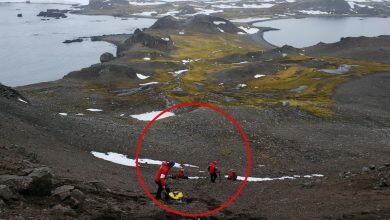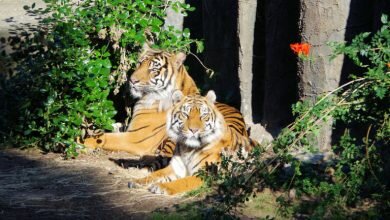State-of-the-art DNA study shows Vikings weren’t all Scandinavians

[Apr 23, 2022: Daniel Lawson, University of Bristol]
Researchers have shown that not all Vikings were from Scandinavia. (credit: creative commons)
Invaders, pirates, warriors – history books taught us that Vikings were ferocious hunters who traveled by sea from Scandinavia and raided their way into Europe and beyond.
Now state-of-the-art DNA sequencing of more than 400 Viking skeletons from archaeological sites spread across Europe and Greenland will rewrite the history books as shown:
-
Skeletons from famous Viking burial sites in Scotland were actually local people who could take on a Viking identity and were buried as Vikings.
-
Many Vikings actually had brown hair, not blonde hair.
-
Viking identity was not limited to people with Scandinavian genetic ancestry. The study suggests that the genetic history of Scandinavia was influenced by foreign genes from Asia and southern Europe before the Viking Age.
-
Early Viking Age raiding parties were an activity for the local people and involved close family members.
-
Genetic inheritance in the UK has left up to six per cent of the population with Viking DNA.
The six-year research project, published in Nature Today, defies the modern image of Vikings.
Mock Viking helmet on display at Waterford.
Co-first author Dr Daniel Lawson from the University of Bristol, led by the University of Cambridge and the University of Copenhagen, was instrumental in the international research.
Related Stories
Dr. Lawson said: “The Vikings have an image of being fierce attackers, and they certainly were. What was even more surprising was how well they assimilated other peoples. Scottish and Irish peoples into Viking society so well integrated that it is sufficient for individuals without Scandinavian ancestry to receive complete Viking burials in Norway and Britain. We studied two Orkney skeletons with Viking swords from Viking tombs, those of extant Irish and Scottish peoples. share ancestry with what may be the earliest Pictish genome ever discovered.”
Work from the School of Mathematics at the University of Bristol has specialized in separating very similar lineages.
“People in Scandinavia were relatively similar during the Viking Age, but we developed advanced methods to differentiate their ancestry. This showed that Norwegians mainly went to Ireland and Iceland, while Danes came to England,” said senior lecturer in data science Dr. Lawson said.
An artistic reconstruction of ‘Southern European’ Vikings emphasizing foreign gene flow in Viking Age Scandinavia. (credit: Jim Lingwild)
“But the Vikings were often diverse, with ancestry from all over Scandinavia and the British Isles found in a single raiding party. The Vikings arriving in Britain and Ireland were part of an extensive migration spanning several centuries.”
The word Viking comes from the Scandinavian word ‘vikinger’ which means ‘pirate’. The Viking Age generally refers to the period of 800 AD, some years before the Norman conquest of England in 1066, until the 1050s, a few years after the earliest recorded raids. The Vikings changed the political and genetic course of Europe and beyond: Kant the Great became king of England, Leif Eriksson believed to have been the first European to reach North America – 500 years before Christopher Columbus – and Olaf Trygwasson Christianity is credited with taking it to Norway. Many campaigns involved raiding monasteries and cities along the coastal settlements of Europe, but trading goods such as fur, tusks and seal fat often had a more practical purpose.
Lead author Professor Eske Willerslev, Fellow of St. John’s College at the University of Cambridge and Director of the Lundbeck Foundation Geogenetics Center in Copenhagen, said: “We didn’t know genetically what they actually looked like until now. We’ve found different Viking populations within Scandinavia. indicating that Viking groups in the region were far more isolated than previously thought.Our research even dismisses the modern image of Vikings with blond hair as many of the Vikings. Had gray hair and was influenced by genetic flow from outside Scandinavia.
The team of international academics sequenced the entire genome of 442 from the teeth of Viking Age men, women, children and children and bones found in Viking cemeteries. They analyzed DNA from the remains of a boat burial in Estonia and found that four Viking brothers died on the same day. Scientists have also uncovered that male skeletons from a Viking burial site in Orkney, Scotland, were actually not genetically Vikings, while they were buried with swords and other Viking memorabilia.
There was no word for Scandinavia during the Viking Age – which came later. But research studies show that Vikings traveled to what is now Norway, Ireland, Scotland, Iceland and Greenland. The Vikings traveled to England from what is now Denmark. And the Vikings went to the Baltic countries on what is now Sweden, all their men on ‘raid parties’.
Co-first author Dr Ashot Margarian, Assistant Professor in the Section of Evolutionary Genomics, Globe Institute, University of Copenhagen, said: “We have carried out the largest DNA analysis of Viking remains to date to determine whether they resemble ancient European peoples. How genetics fit into the picture. Before the Viking Age. The results were shocking and answer some long-standing historical questions and confirm previous assumptions that lack evidence
“We determined that a Viking raiding party expedition involved close family members because we discovered four brothers who died on the same day in a boat burial in Estonia. The rest of the people aboard the boat were genetically identical. which suggests that they all came from a small town or village in Sweden.”
DNA from Viking remains was shotgun sequenced from sites in Greenland, Ukraine, the United Kingdom, Scandinavia, Poland and Russia.
The team’s analysis also found that the Pictish people became ‘Vikings’ without genetically mixing with the Scandinavians. The Picts were a Celtic-speaking people who lived in what is today eastern and northern Scotland during the late British Iron Age and the early Medieval period.
The Viking Age changed the political, cultural and demographic map of Europe in ways that are still evident today in place names, surnames, and modern genetics.
Professor Soren Sindbeck, an archaeologist at the Mosegrd Museum in Denmark who collaborated on the ground-breaking paper, explained: “The Scandinavian diaspora established trade and settlement stretching from the American continent to the Asian steppe. They exported ideas, technologies, language, beliefs and practices and developed new socio-political structures. Importantly our results show that ‘Viking’ identity was not restricted to people with Scandinavian genetic ancestry.”
Assistant Professor Fernando Recimo, a lead author based at the Center for Geogenetics at the University of Copenhagen, stressed how valuable the dataset is for the study of complex traits and natural selection in the past. He explained: “This is the first time we can take a detailed look at the evolution of variations under natural selection over the past 2,000 years of European history. Viking genomes allow us to understand that before Viking movements across Europe, How selection unfolded during and after, affecting genes associated with important traits such as immunity, pigmentation and metabolism. We can even begin to infer the physical appearance of ancient Vikings and compare them to the Scandinavians today.”
The genetic legacy of the Viking Age is still alive today, with six per cent of the UK population predicted to have Viking DNA in their genes, compared to 10 per cent in Sweden.
Professor Willerslev concluded: “The results change the perception of who the Viking really was. The history books will need to be updated.”
Check out our New Discovery section for more science news bright side of the news,
Note: Materials provided above by University of Bristol. Content can be edited for style and length.
Like feel good stories like this? bring The Bright Side of the News’ newsletter,
Tags: #new_discovery, #global_good_news, #vikings, #genetics, #lineage, #genology, #research, #The_Brighter_Side_of_News




